The most beneficial trees for livestock
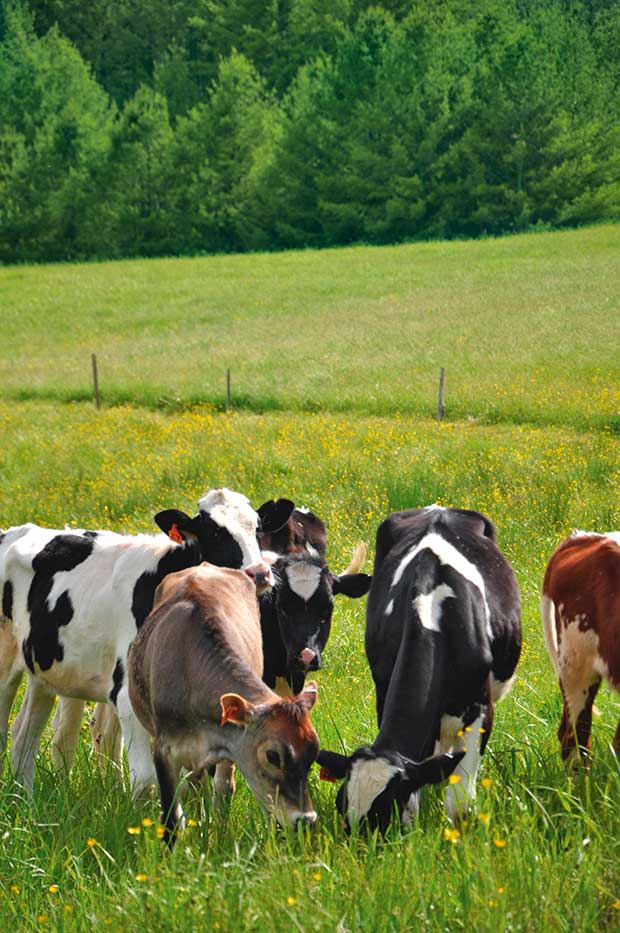
Having animals without trees means you have only half an ecosystem. Trees provide shelter, food, and medicine, capture and recycle waste, and provide habitat for beneficial companions. These are trees your stock can benefit from.
Words: Sheryn Dean
Cows like ryegrass and it makes them fat. I like chocolate and it makes me fat.
But I couldn’t live on chocolate all day, every day. I guess I would get sick of the taste, and my body needs a wider range of nutrients. So does a cow.
Fodder trees can provide a range of healthy additives to an animal’s diet and help to prevent intestinal worm burdens (anthelmintic). They also:
• increase the feed produced on an area of land
• are a good source of supplementary feed in times of drought or winter shortage
• provide shade and shelter to increase a beast’s comfort, wellbeing and production
• stabilise the soil and recycle nutrients back to your pasture
• look good
Quite frankly, every farm needs them.

Our cows enjoy the prunings off all the fodder trees on our block.
TREES PROVIDE HEALTH BENEFITS
That some trees are beneficial to an animal’s health is well known to many farmers. Science has yet to fully research all their effects and much information is anecdotal, but condensed tannins in trees (which is concentrated in the bark) have proven to have anthelmintic (deworming) effects.
Some improve the protein uptake in the animal’s gut which has been shown to help livestock grow faster and resist infection and disease. Some plants cause the host animal to expel the parasites’ eggs, others prevent the parasite’s normal lifecycle, reducing the burden the animal has to carry.
Other trees can improve digestion, or help to prevent bloat or facial eczema. Some can have more general health benefits, like reducing arthritis. Other trees can repel flies and other pest insects from their immediate zone, making them great shade trees.
TREES TURN YOUR FARM VERTICAL
Grass takes up comparatively little depth and height.
By layering your pasture with trees with roots the go below that of the grass, you capture nutrients that have leached down and turn them into leaves or fruit that stock can eat.
You don’t have to bother making hay. Simply cut branches when grass is in short supply, or let the leaves drop and compost into the soil.
You are producing a lot more feed in the same space and creating an easy secondary source of supplementary feed.
THE BONUSES: SHADE, SHELTER, STABILISATION
Research has proven that dairy cows produce more milk if provided with shelter. Commonsense dictates that shade on hot days and shelter from cold winds and rain in cold weather will increase your animal’s happiness, health and wellbeing.
When you put on some slippers and snuggle up to the fire this winter, think of your stock outside. If they are using up energy to stay warm, they’re not comfortable, and they’re not turning it into milk or meat either.
The least you can do is provide them with shelter, and trees do this cheaply and effectively. Meanwhile, the trees also provide habitat for birds and beneficial insects which control pests in your pasture. Their roots are stabilising the soil from erosion, and they provide future sources of timber or firewood, aesthetics and bee food.
SHERYN’S TIIP: ALWAYS USE GOOD PROTECTION
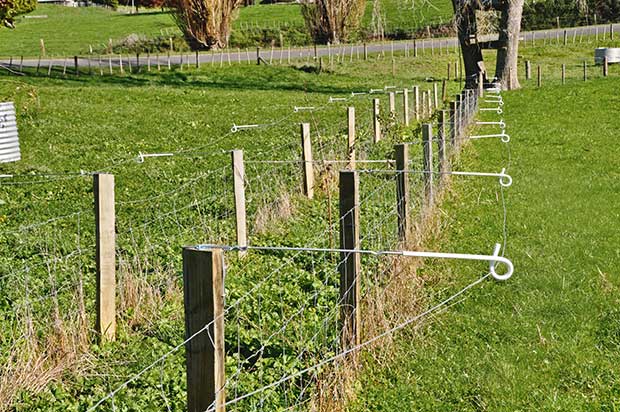
While trees are a great source of fodder, their very attractiveness means they need to be well protected from overgrazing. Even when 10 years old, my oak trees had the bark stripped off them by cows, so consider any protection permanent.
My favourite has become a double netting fence dividing the paddocks, with a hot wire on a pig tail as an outrigger. This means the fenced-off area is only a metre wide, but completely sheep-proof and the cows cannot reach over to nibble on the trees.
FRUIT TREES
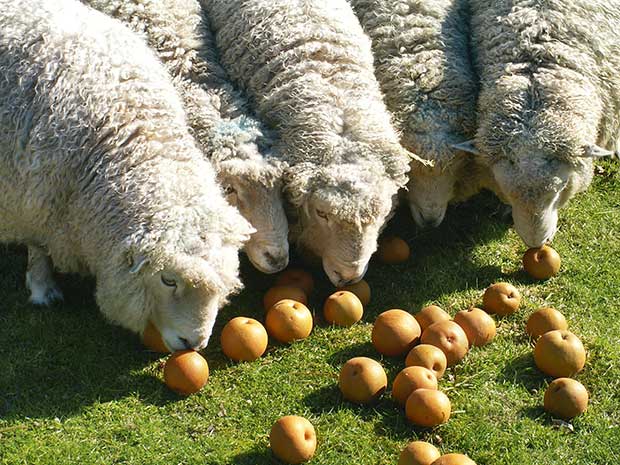
My sheep love our Nashi pears.
Timing: autumn (fruit)
My first choice of a fodder tree for cows would be a pear tree, and then some apples. Pears grow quite large, making a nice shade tree. If you’re choosing apple varieties, get ones grown on large and hardy Northern Spy or similar rootstock.
• both drop fruit in autumn which my cows adore – for them it is mana from heaven – and I can gather some fruit for myself;
• birds can eat the fruit (instead of what is in my orchard!);
• they drop their leaves in winter, so you don’t end up with muddy areas around them, making them good options on northern sides of gates or races;
• they also make great firewood (or smoking wood).
On the downside, the over-ripe fruit can attract wasps and possums and they may get infected with codling moth (althought there are now biological sprays to control
the larvae, see next month’s column for more).
2. NUT TREES
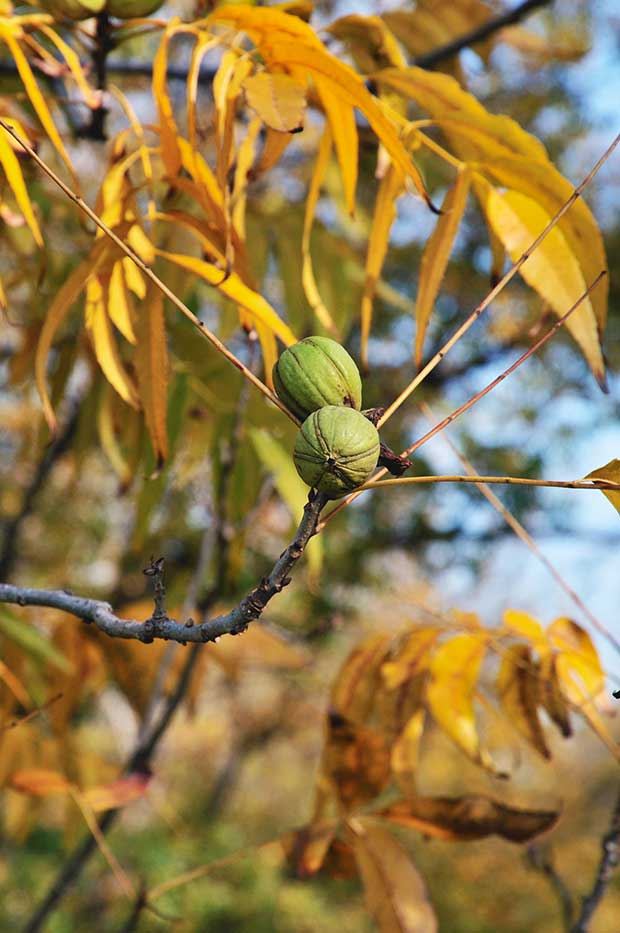
Pecan.
Timing: summer (leaves), autumn (nuts)
Nuts make excellent stock (and human!) food, and cows, sheep and pigs will all learn to eat them. They are also very long-lived trees and provide good shelter.
Walnuts inhibit grass growth underneath which can be muddy in winter, but they also help to deter flies, lice and mites from their zone in summer.
Pecans like stream edges and live for centuries but you need several near to each other for pollination.
Hazelnuts are smaller, you need several to pollinate each other, and make a great hedgerow shelter.
The leaves are also good fodder in summer and the wood has numerous uses.
Chestnuts have a very prickly burr, but I have seen sheep learn to stamp them open to get the nuts out. The leaves, bark, chestnut pellicle and skin are all anthelmintic, and research in NZ is proving its benefits and attractiveness to alpacas. On the downside, rats can be attracted to the nuts.
3. MULBERRY
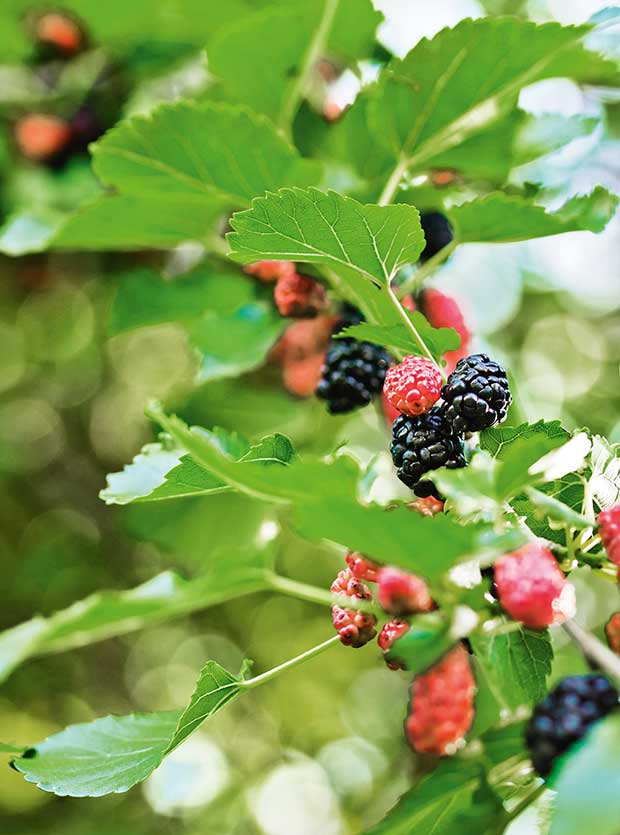
Mulberry.
Timing: summer (berries, foliage, branches)
Mulberries are a great choice:
• they have exceptionally sweet wood – stock love it;
• cut and feed the leaves and young branches – stock will eat the lot;
• bird love the berries, and you can harvest them for a pie;
• they grow into attractive shade trees;
• they have very deep roots for soil stabilisation.
Dress children in old clothes when they go to raid the berries – stains are difficult to remove.
4. OAK TREES
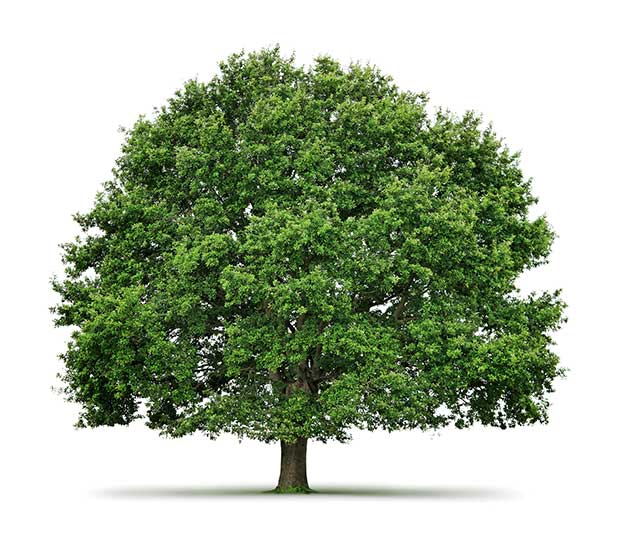
Oak tree.
4. OAK TREES
Timing: summer (leaves), autumn (acorns)
Excessive amounts of green acorns or spring leaves (approximately 50% of their diet) can be toxic, but once matured, oak leaves are a nutritious and beneficial stock food, and are known to ‘bind’ up runny manure caused by lush grass.
• aged, brown acorns are an excellent source of starch and nutrients for ducks and pigs;
• leaves are a beneficial supplement for cows;
• quick-growing long-lived shade tree;
• excellent timber and firewood tree;
• deciduous, some varieties have lovely autumn colour.
5. WILLOW
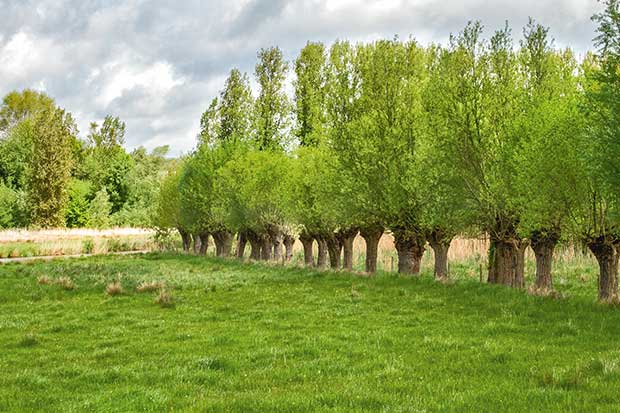
Willow trees.
Timing: summer (foliage, branches)
Willow bark is the original source of aspirin and contains many other beneficial chemicals. Willow leaves and small stems (less then 10mm) are superior to summer pasture and, once introduced to an animal, can be fed in quite large amounts.
Other benefits include:
• quickly grows a large amount of fodder which can be completely harvested every 2-3 years;
• can be pollarded or even grown as a crop and rotationally grazed;
• male trees provide pollen for bees in early spring when bee food is scarce;
• likes wet areas and is good for stabilising stream banks;
• an anthelmintic for horses and all livestock (and humans), and a decoction of the bark is efficacious against flukes (trematode parasites) and diarrhoea in sheep.
On the downside it can get infected by the newly-arrived giant willow aphid.
This sap sucker depletes the health of the tree and produces a honeydew which is detrimental to honey if bees harvest it. It tends to ‘gum’ up the honey, making it very hard – one beekeeper describes it as “a comb, set like plastic glass, with sticky runny fluid that resists extraction.” The hard honey will feed bees but clogs up the hive, and can attract wasps that will kill the bees to get it.
You can read more about giant willow aphids here.
Willow trees can be pollarded and cropped for fodder every 2-3 years.
6. POPLAR
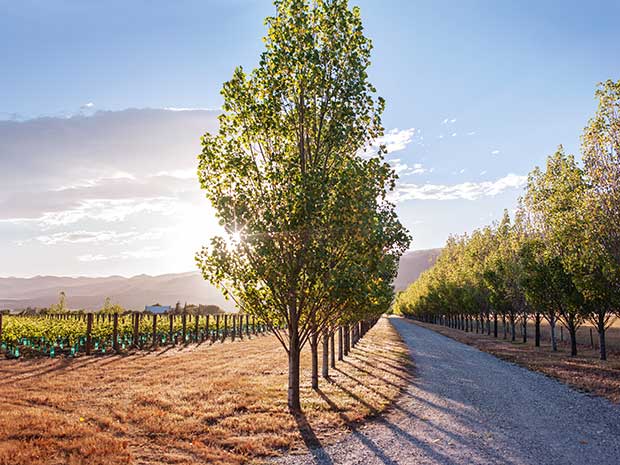
Hardy Veronese poplars line the driveway into the vineyard.
Timing: summer (foliage, branches)
Zinc is often administered to cows in the North Island to prevent facial eczema. Poplar leaves, particularly Populus yunnanensis, are naturally high in zinc. Other benefits include:
• falling leaves in autumn are eagerly consumed by sheep and cattle;
• fast growing – branches can be cut
and fed out;
• grows well on dry sites;
• stabilises soil;
• good shelter.
P. yunnanensis is also rust-resistant and unpalatable to possums.
7. TAGASASTE/TREE LUCERNE
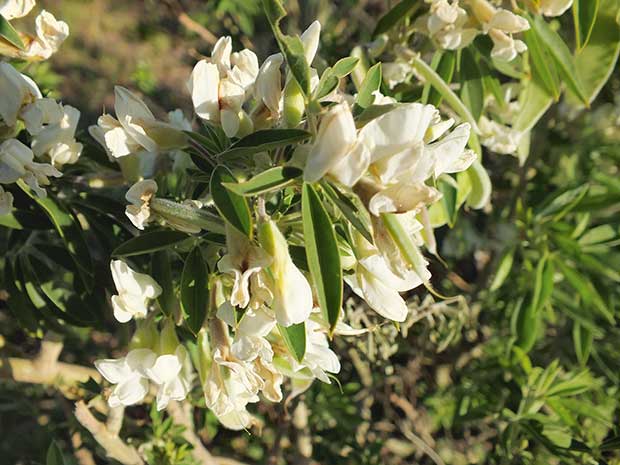
Timing: winter (foliage, branches)
This tree is a native of the Canary Islands and is naturally frost tender, but strains have acclimatised to grow as far south as Central Otago. Source locally if you get severe frosts.
Benefits include:
• is evergreen so can be used as winter feed, sheep particularly enjoy it;
• cut and allow to regrow;
• is lush with a high nutritional value;
• a favourite of wood pigeons;
• flowers in early spring for bees.
8. LOCUST SPECIES
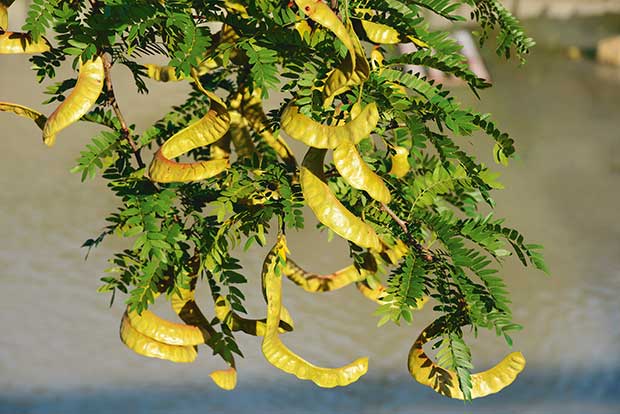
Gleditsia triacanthos.
Timing: spring-summer (foliage, pods)
Locusts are a large brown bean produced by trees and favoured by animals (and humans) for centuries. These trees are high in sugar and protein and beneficial nutrients.
Carob locust (Ceratonia silique) is literally chocolate for cows. The female tree produces pods that drop when ripe. It is a slow-growing, long-lived tree evergreen tree that does not tolerate frost or waterlogging but is very hardy in a hot, dry climate. Honey locusts (Gleditsia triacanthos, also known as gleditsia) will tolerate frosts and wetter climates and produces a high yield of pods. Thornless varieties can be sourced.
Both are legumes, so it is likely but unknown if they fix nitrogen in the soil.
WHY POLLARDING IS A GREAT WAY TO MANAGE FODDER TREES
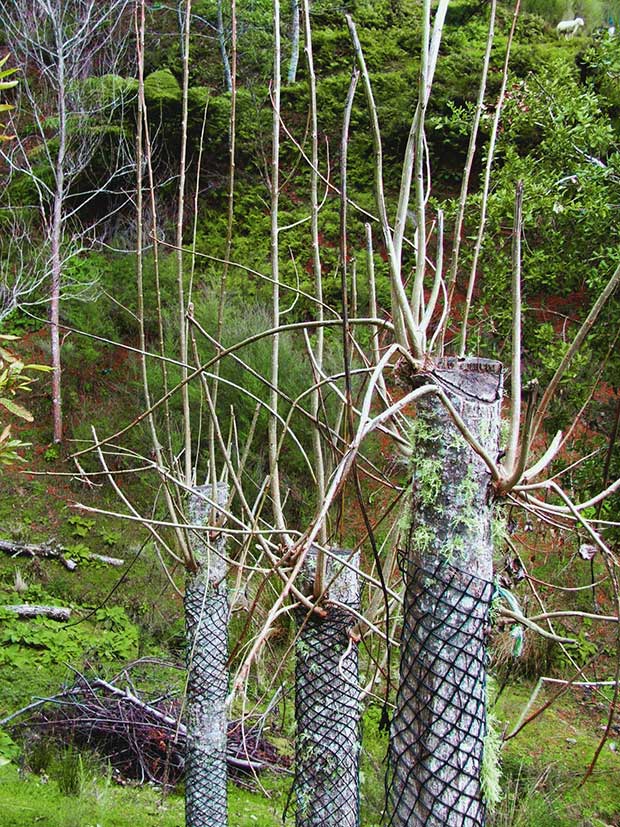
Pollarded trees are cut high – cut to around shoulder height means it’s still safe if you’re using a chainsaw.
Good options: mulberry, willow, poplar
Pollarding is cutting your tree down and leaving a tall stump to regrow. It is similar to coppicing which cuts a low stump (near ground level), but pollarding is where you cut it higher (about shoulder height) so the new growth is above grazing height.
You want to cut in summer to supply fodder, so ensure your tree is mature and established enough to regrow the following spring. Fully pollard only every 2-6 years, or alternatively remove 50% of the branches each year.
WARNING: GO SLOW WHEN FEEDING OUT
Never allow hungry stock sudden access to large amounts of a new food. Sudden changes to their diet can cause gastric upsets and can even be fatal.
All new foods need to be gradually introduced to their diet, and as an option. As a general rule, none of these trees should exceed 5% of their dietary intake.
Some stock may take a while to learn to eat new foods, and older stock can show them how to do so.
PLANTS NOT TO FEED TO STOCK
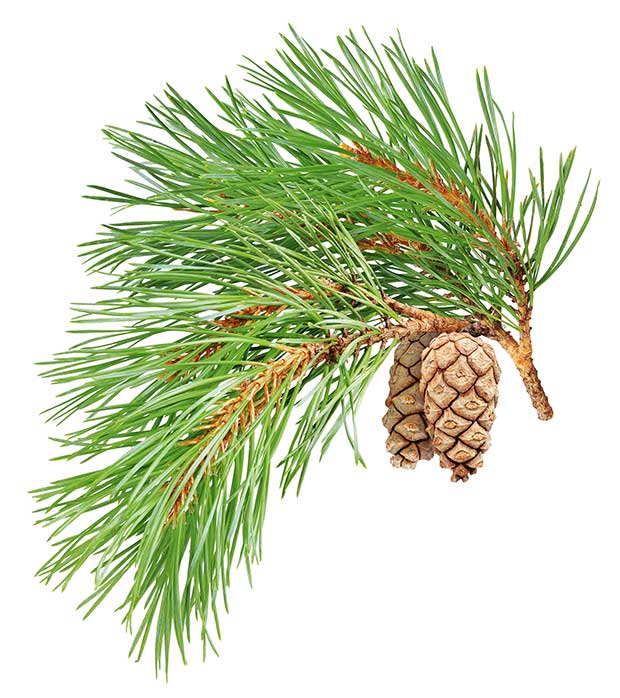
Pine.
A few plants are toxic to stock. Well-fed, mature animals will usually not eat them, but they are poisonous and those animals most at risk are the hungry, young, curious, bored or naïve.
Toxic plants not usually eaten are more palatable if cut and allowed to wilt so a basic rule should be don’t throw garden prunings over the fence, or grass cuttings that might contain their foliage (and don’t do that anyway as hot grass cuttings can cause bloat and death).
It can take just mouthfuls of plants like native tutu, or rhododendron or oleander, especially in young, old or health-compromised animals, to make them very sick or even kill them. Plants to keep away from stock include:
• rhododendron
• azalea
• oleander
• yew
• ngaio
• cestrum
• kowhai
• karaka
• macrocarpa and pines (needles can cause cows to miscarry)
• hemlock
• tutu
• some lilies, including the large and common arum lily
• avocado leaf and fruit skin, particularly to horses
• green acorns, especially in young animals but all ages affected, mortality rate is 10-20% and there’s little treatment to save an affected animal.
Love this story? Subscribe now!
 This article first appeared in NZ Lifestyle Block Magazine.
This article first appeared in NZ Lifestyle Block Magazine.
